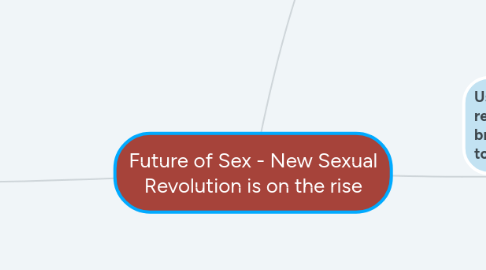
1. Ethical and clinical challenges arising with these changes
1.1. doctors unaware of the fluidity of sexual diversity of their patients to suggest the proper treatment
1.1.1. married couple been non-monogamous might need STIs testing but the doctor wouldn't know it unless the patients mention it
1.2. doctors are uncomfortable with the topic of sex - Kerry Bowman
1.2.1. unaware of sexual basics for treatment
1.2.1.1. Plastic surgeon who assumed the clitoris is the only part of the vagina that stimulates orgasm while performing a hood reduction of the clitoris
1.2.2. doctors get very little medical treatment in the field of sex
1.2.2.1. 4-10 hours over a four year study period on sexuality is not enough information and training
1.2.2.1.1. UofT incorporates sexual health in various learning methods throughout the medical training period
1.3. medicine has a lot of catching up to do
1.3.1. needs of sexual minorities, seniors and disabled people are overlooked and or discriminated
1.3.1.1. pre-existing laws discriminating against unmarried couples or those polyamorous relationships with multiple partners comparison to the resources offered to married couples
1.4. culture of medicine
1.4.1. previous prejudices and assumptions of patients to be culturally heterosexual - doctors have to be open-minded and aware of the sexual diversity of their patients - TRADITIONAL CULTURE
1.4.1.1. a medical survey of med students showing anti-LQBQT jokes and bullying against sexual minorities
1.5. sexually transmitted diseases and sexual dysfunction are increasing
1.5.1. premature ejaculation in men
1.5.2. trouble achieving orgasm in women
2. The Future of Sex - Lauren Vogel
3. Fluid definitions of sexuality and identity are emerging challenging past rigid definitions
3.1. Past definitions were in binaries - male or female; gay or straight
3.2. Generation Z describes them as queer instead of classifying themselves under one of the groups in the LGBQT umbrella
3.2.1. allowing patients with fluid definitions to self-identify
3.2.1.1. allow doctors to give the right kind of treatment or resources catered to the sexual needs of their patients
3.2.1.1.1. example of a non-monogamous married couple to get tested for STIs
4. Use of technology in relationships and bringing awareness to sexuality
4.1. Digisexual - technology wedded with sex
4.1.1. First wave digisexuals
4.1.1.1. use dating apps; sexting - use of technology in relationships
4.1.1.1.1. pros: helps with social anxiety or self conscious issues
4.1.1.1.2. cons: depression when online partner disappears; rise in STIs with use of dating apps
4.1.1.2. pornography and online sexual information access
4.1.1.2.1. pros: tumblr safe space to discuss queer sex and in building an info bubble for that community
4.1.1.2.2. cons: early sexual activity, attitudes and aggression; misinformation; limited research on the effects; information is limited and politicized; monopolized views of tech companies - anti-sex/ anti-queer campaigns - porn ban on tumblr queer space
4.1.2. second wave digisexuals
4.1.2.1. virtual reality porn and sex robots
4.1.2.1.1. pros: cheaper models can be made; AI can be used to teach consent and healthy sexual relationships; therapeutic for those who cannot easily access sex - sexually traumatized individuals and people with disabilities; explore sexuality legally; close intimacy gaps
4.1.2.1.2. cons: expensive; distorted view of women; modelling consent
4.1.2.2. see the opportunities
4.1.2.2.1. seniors in long term care
4.1.2.2.2. people with disabilities
